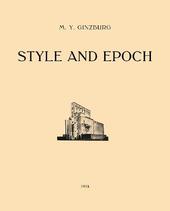
|
Style and Epoch: Issues in Modern Architecture
Paperback / softback
Main Details
| Title |
Style and Epoch: Issues in Modern Architecture
|
| Authors and Contributors |
By (author) Moisei Ginzburg
|
| Physical Properties |
| Format:Paperback / softback | | Pages:240 |
|
| Category/Genre | History of architecture |
|---|
| ISBN/Barcode |
9781906257293
|
| Classifications | Dewey:724 |
|---|
| Audience | |
|---|
|
Publishing Details |
| Publisher |
Fontanka
|
| Imprint |
Fontanka
|
| Publication Date |
3 January 2019 |
| Publication Country |
United Kingdom
|
Description
First published in 1924, a facsimile of the architect Moisei Ginzburg's key work, the philosophical basis for the Constructivist group of architects. Style and Epoch by Moisei Ginzburg, first published in 1924, was the architect's key work; it became the philosophical basis for the Constructivist group of architects. Ginzburg defined the new style in architecture that signified a break from traditional styles. After two industrial revolutions, architects were faced with new challenges by society. The response was an innovative approach to architecture that put people - their needs and functions - at its centre. The author's understanding of global economic and cultural processes is evident in his description of the development of a style that came to define the nature of architecture in the twentieth century, which today we call modernism. The significance of this book in terms of an understanding of culture, the avant-garde and the subsequent development of modernist architecture is hard to overestimate.
Author Biography
Moisei Ginzburg was an architect, theorist, teacher and a leader of the Constructivist group in Soviet avant-garde architecture. His magnum opus, Style and Epoch (1924), emphasized the civilizing role of the machine and its capacity to rationalize new building types consistent with the needs of the working class. Asserting that the revolution had engendered a new constructive phase of architectural development, Ginzburg's treatise was essentially a manifesto of Constructivism as the architectural style of the new Soviet era.
|